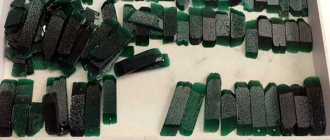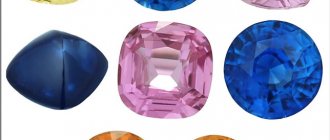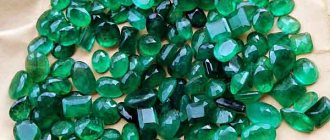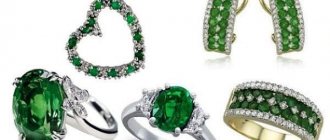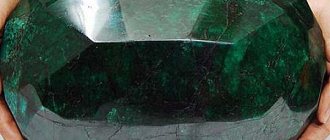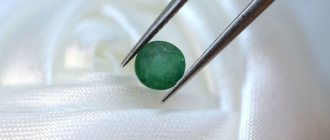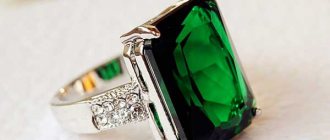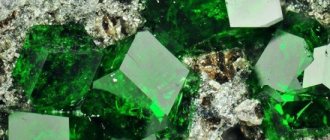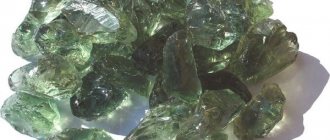When choosing jewelry with emeralds, rubies or other precious stones, you can almost always find the “GT” mark in the description. It means that the pebble insert is hydrothermal. But what is a hydrothermal gemstone, accessories, jewelry or jewelry?
The origin of the mineral is interesting, its reputation is impeccable.
Background
They tried to grow precious minerals two hundred years ago. The object of attention was ruby and emerald as the rarest, most beautiful and expensive.
The first hydrothermal emeralds of jewelry grade were obtained by the American Emily Flanigan at the dawn of the 1960s. However, the process died out before it was completed, and the crystals had to be transplanted into another “box” for growth.
Ten years later, Soviet scientists solved this problem. They achieved permanent, non-transplantation growth of emerald crystals from hydrothermal solutions. Today in Russia a technology has been developed that is also used to create other precious and semi-precious stones.
Hydrothermal gems
Nanoemeralds
Scientists have tried unsuccessfully for many years to invent an analogue of the rare green gem. And only recently, during experiments with beryllium silicate, they managed to grow a crystal similar to an emerald.
To do this, silica and alumina are added to the crucible, which react with beryllium, and then everything is immersed in an autoclave, where it gets very hot. The desired shade of artificial emerald is given by chromium and aluminum oxide.
Hydrothermal emeralds are distinguished by the presence of brown impurities and microscopic bubbles. These features are visible only on special equipment.
Nanoemeralds, unlike natural ones, do not fade in the sun. They are more resistant to chipping and cracking. Read more about these minerals in the article “Emerald Stone: How to Choose the Right One.”
Production technology
From the term “hydrothermal” it is clear that we are talking about water plus high temperature.
The technology for producing hydrothermal stones consists of crystallizing the substance from a hot aqueous solution at 650–700 °C and a pressure of 1500 atmospheres (1.5 Kbar).
Equipment
Hydrothermal stones are grown in an autoclave - a special vessel made of high-strength, corrosion-resistant steel. It is also called the growth chamber:
- A diaphragm - a hardened perforated plate - is fixed in the center. It serves as a separator between the “cold” and “hot” zones. This is the raw material dissolution zone (lower, under the separator) and the crystal growth zone (upper, above the separator).
- Seed plates are installed in the upper segment. They are carved from the natural stone they want to obtain. Crystals will grow on them.
Installation for growing from hydrothermal stones
Before the start of each cycle, the walls of the container are tested for defects: the slightest deviation causes an explosion.
Stages
The hydrothermal process includes the following steps:
- The raw material mixture is placed at the bottom - a substance that will dissolve. They are crushed precious or semi-precious minerals of non-jewelry grade. To create an emerald it is beryl.
- Then a mineralizer is added - the salt component of the aqueous solution. This is a mixture that increases the solubility of raw materials with a hydrothermal solution. Consists of the same elements as natural stone. Thus, vanadium and chromium are additives for emerald.
- The loaded autoclave is tightly closed at the top and fed into the oven. Heats up to 650–700 °C, experiencing a pressure of 1500 atmospheres (1.5 Kbar).
- The lower part gets hotter. The solution is saturated with the components of the charge, and thermal convection delivers its vapor to the growth zone.
- Here they cool, becoming supersaturated. Excess substance accumulates on the seed plates.
This is how crystal growth occurs.
Peculiarities
The peculiarity of the process is the variety and alternation of temperatures. The vessel is heated from below and cooled from above. This allows you to avoid the “underbaking” of individual sections of the future crystal and create agglomerates of the correct structure.
Four weeks later, the result is ready. The technology allows you to regulate the direction of growth, shape, and color of the crystal.
Hydrothermal sapphires, rubies and emeralds. What is this?
| Modern technologies make it possible to achieve simply stunning results. Precious emeralds and sapphires, created by the will and skill of people, are practically no different in quality from their natural counterparts, and it is completely impossible to recognize the differences visually. Only an experienced jeweler can, looking at a sapphire shimmering in a ring or an emerald playing in a pendant, say for sure that the crystal was created not by nature, but by man. Ordinary “wearers” of jewelry, if you do not tell them, but hide this fact, will be sure until the last moment that these are real sapphires and emeralds. |
Jewelry with hydrothermal inserts: sapphires, emeralds and rubies of a new generation Precious stones have been valued at all times. What makes them so expensive is their exclusivity and small quantities, mined only in a few places on the planet. But a much larger number of people want to decorate their image with exclusive jewelry inlaid with multi-colored or completely transparent gems. And to give them all such a chance, scientists have developed a special technique for creating crystals in laboratory conditions. Moreover, the quality of the resulting stones is so good that only jewelers armed with special equipment can distinguish them from natural originals. This method of growing precious stones artificially is called hydrothermal, which immediately makes it clear that the main role in it is played by the temperature regime. We won’t delve into the technological jungle; we’ll just note that the hydrothermal method is not entirely simple, so it won’t be possible to repeat it in artisanal conditions. Only strict adherence to all recommendations will give an excellent result in the form of an emerald green crystal with an ideal structure (or any other stone whose appearance and internal structure was taken as a basis). But the greatest demand for hydrothermal sapphires and emeralds comes from their cost. Almost anyone who has such a desire can buy jewelry with artificially created stones. And the price will not become a stumbling block preventing you from making a purchase, while natural gems will immediately increase the cost of any jewelry several times, making it almost unattainable for some. Jewelry with synthetic inserts appeared in online store catalogs relatively recently. Our ancestors could not even imagine that the owners of exclusive jewelry would not be counts and princes, but ordinary families whose income did not exceed the average for the region. And at the same time, the appearance of the products not only did not become worse, but also improved, because jewelers who do not work with hydrothermal jewelry inserts no longer have to come up with a design based solely on the quality of the gemstone. They simply fantasize to the fullest, knowing that synthetic crystals will have ideal proportions and an ideal structure to realize any idea.
| All crystals of synthetic origin are conventionally divided into 2 large segments: - those that replicate precious stones found in nature, - those that do not have a natural analogue. |
The first category includes emeralds and rubies, diamonds and sapphires; and for the second - cubic zirconia. Each synthetic stone is a separate segment of the jewelry market. Jewelers are becoming increasingly accustomed to working with artificial crystals because of their ideal structure. And since technological progress does not stand still, the catalog of synthetic jewelry inserts is regularly replenished with new items, forcing buyers to shell out for more and more exclusive jewelry. There are crystals that are no longer produced, since their demand after the appearance of new products has dropped to critical levels. And only hydrothermal (synthetic) sapphires and emeralds continue to remain among the top gemstones of artificial origin. Their beauty is so original and luxurious that buyers try to buy at least one model of jewelry, delighting their loved ones with unusual gifts. The art of jewelers has already increased so much that visual analysis alone is no longer enough to clearly identify sapphires or emeralds grown by the hydrothermal method. Using standard gemological studies, not every jeweler can accurately determine whether the gem in front of him is a natural one or a synthetic analogue, so increasingly it is necessary to use one of those complex techniques that do not destroy the structure of the crystal, but at the same time allow one to give a clear answer to the question. The best results are obtained by a complex of several procedures, which once again suggests that buyers are unlikely to be able to visually determine which stone is in front of you. Therefore, many people prefer not to spend too much money on jewelry with natural precious stones, but to buy several models with synthetic emeralds (or sapphires). And given the huge assortment of jewelry with hydrothermal jewelry inserts in the catalogs of online stores, you can afford any whim. And the cost of such products will never allow you to feel even the slightest note of dissatisfaction with the purchase. You can often hear from buyers that synthetic gemstones are fakes. And that they are significantly inferior in appearance to natural gems. But it’s easy to argue with this statement if you buy jewelry with synthetic emeralds and look at it more closely. Most likely, it will not be possible to notice any special differences in appearance, since this requires special laboratory equipment. Just one glance (even the most attentive) will not be enough to determine how the gemstone was created. In terms of their optical properties, synthetic sapphires, like emeralds, are no different from natural ones. Having only small inclusions of a characteristic shape, these stones are practically free of both external and internal flaws. When passing on jewelry by inheritance, everyone wants the precious product with jewelry inserts to retain its attractive appearance and the original parameters specified in the certificate for a long, long time. But it often happens that even the most expensive and exclusive jewelry is severely damaged and can no longer satisfy the exacting demands that subsequent owners put forward to them. And there comes a terrible disappointment: after all, not everyone can buy something like this; the cost of such jewelry can reach sky-high heights. But many people can buy jewelry with hydrothermal sapphires, rubies and emeralds, making these products real family heirlooms, whose “biography” goes on and on.
| Jewelry with emeralds Gold rings with emeralds Gold earrings with emeralds Gold pendants with emeralds | Jewelry with rubies Gold rings with rubies Gold earrings with rubies Gold pendants with rubies | Jewelry with sapphires Gold rings with sapphires Gold earrings with sapphires Gold pendants with sapphires |
Hydrothermal emeralds: those that are “greener than green” This is exactly the translation from Greek of the word “emerald”. And it’s hard to come up with a more accurate name: the Greeks knew a lot about precious stones. The rarity of emeralds has made them the most popular and sought after crystals on the planet. Scientists have tried for many years to reproduce them in the laboratory, but their attempts have come to nothing. And only very recently, as a result of experiments with the production of beryllium silicates, gems began to be produced that are very much reminiscent of emeralds. Today, the best samples are considered to be those where alumina and silica were placed in a crucible, and then all this was sent to an autoclave with a high temperature regime. Maturation takes about a day, and the color saturation of hydrothermal emeralds depends on compliance with the synthesis conditions. At each stage of cultivation, the temperature changes, which leads to certain changes in the structure of the crystals, creating gemstones of the desired mass, length and weight. Chromium is necessarily introduced into the composition, which gives the desired emerald hue, after which artificial gems are visually indistinguishable from natural ones. The technology for producing hydrothermal emeralds has remained unchanged for many years; only the equipment and instrumental parts have been improved, which allows for maximum control at each stage of the synthesis. Another advantage of hydrothermal emeralds compared to natural ones is their resistance to ultraviolet radiation. Natural stones very quickly, when exposed to UV rays, lose their rich emerald hue, as if fading. But synthetic emeralds do not feel this spectrum of influence at all, remaining the same as at the time of purchase. Therefore, it is recommended to take jewelry with hydrothermal emeralds with you on vacation, showing off on the beach in luxurious earrings and not worrying about their appearance. Hydrothermal emeralds do not have the slightest flaw in their structure, so they are not particularly susceptible to mechanical damage. So, where a real emerald already has a chip or crack, the synthetic crystal will remain without any defects. If you look especially closely and use professional equipment, hydrothermal emeralds can be identified. This is not an easy matter, but if you approach it wisely, it is quite possible. Characteristic features of hydrothermal emeralds: - they always have tubular inclusions, - they contain brownish impurities, which are iron oxide, - their structure contains gaseous bubbles of microscopic size. When the question arises whether or not to buy jewelry with hydrothermal inserts, I immediately want to say the following. Definitely worth buying, because in their beauty they will not differ from classic natural ones. But their cost will allow you to make a few more pleasant purchases, delighting all your loved ones. The whole question is that the buyer must clearly understand what he is paying money for and what he is really buying. Reputable online stores will always indicate in the certificate that the jewelry inserts in a particular piece of jewelry are created artificially, without misleading customers. And the person decides for himself whether such a product is suitable for him or not. As noted earlier, synthetic (hydrothermal) jewelry inserts are not inferior in aesthetic parameters to expensive natural ones, so the pleasure from owning these luxurious jewelry will be no less. And artificial crystals have much fewer defects.
| The following is important! Don’t pay too much, thinking that this is a natural stone with an ideal structure, which costs several tens of times cheaper than similar analogues in other stores. The most important thing in buying hydrothermal stones is their real cost, so you should always buy jewelry in a trusted jewelry store, and not be led by scammers who offer “natural” gems for the price of ordinary glass. |
Therefore, a stone that, being of artificial origin, was sold as natural, should be considered a fake. All other options imply that the created crystal is absolutely similar in its parameters to its natural counterpart. But at the same time, it has a correspondingly lower cost.
8 phone number for ordering exclusive jewelry. Call and order exactly the jewelry you want.
- Reviews:
(0)
What stones are most often copied?
Hydrothermal treatment of stones is applicable to obtain many types of precious crystals. There are several in demand by jewelers:
- Emerald. It grows in a month and can have the desired green tint and glassy sheen. Also fragile, but without cracks, therefore more durable than natural. Indifferent to acids or high temperatures.
Emerald hydrothermal
Hydrothermal emerald is recognized as a full-fledged analogue of natural stone.
The technology developed by Soviet scientists from Novosibirsk is considered the best and commercially profitable. It is a de facto monopolist on the world market, displacing products obtained by other growing methods (Chinese, Biron, Malossi). Emeralds are sold under the brands Russian emerald (“Russian emeralds”) - cut stones of small fractions and Colombian color emerald (expensive large-sized processed specimens).
Table No. 1. Properties of hydrothermal emerald (grown).
| Formula | Be3Al2Si6O18 |
| Impurity | Fe2O3, V2O3, Cr2O3 |
| Color | Dark green, blue-green |
| Stroke color | White |
| Shine | Glass |
| Transparency | Transparent, translucent |
| Hardness | 7.5-8.0 on the Mohs scale |
| Cleavage | Imperfect |
| Kink | Conchoidal, uneven |
| Density | 2.69—2.78 g/cm³ |
| singonia | Hexagonal |
| Refractive index | nω = 1.564—1.595, nε = 1.568—1.602 |
- Citrine . Painting is done to order. Gloss and transparency at the highest level.
- Corundums . Hydrothermal rubies and sapphires are taken by the jewelry industry.
- Quartz . A popular jewelry imitation is amethyst. It is in demand due to its purity, degree of transparency, color saturation, and absence of internal defects. It is possible to distinguish hydrothermal amethyst from natural one only using special analyzers.
Quartz with specified parameters is also created for scientific, research, and industrial needs.
Considering the temperature and pressure parameters, it is impossible to create a crystal at home using the hydrothermal method.
The quality of the final product is indicated by the following fact. In Germany, such crystals are not called hydrothermal, synthetic or artificial, but cultural.
How a synthetic ruby is born
The Verneuil method allows you to grow crystals in much the same way as stalagmites grow in a cave. Finely ground aluminum powder, or charge, is poured in a thin stream into a special furnace, where it enters the flame of detonating gas. The flame is heated to very high temperatures - more than 2000 degrees, so the powder melts. Drops of the melt flow down onto the stand with the seed and crystallize, forming a corundum boule.
The Czochralski method is used when high-quality gem quality rubies are needed. The crystals are more uniform, with fewer gas bubbles and inclusions, and a low level of residual stress. At the same time, the Czochralski method is more expensive: its use requires expensive equipment, as well as crucibles made of refractory metals - for example, platinum.
When synthesizing rubies using the Czochralski method, the initial mixture of oxides is placed in a crucible and heated with a spiral heater. A seed rotating at a speed of 5-30 mm/hour is brought to the surface of the melt. It gradually rises, “pulling” the crystal upward. As a result, a ruby is formed with a length of 200-250 mm and a diameter of up to 20-30 cm.
RusGems ruby grown using the Czochralski method
Fake or not?
Hydrothermal stone does not mean fake in the standard sense.
The duality of the nature of stone
This is an intermediate stage between natural material and synthetics:
- Synthetic because it is grown in a laboratory at an accelerated pace. Natural stone takes millions of years to form, laboratory stone takes a month and a half.
- It differs from synthetic in composition. The raw materials of hydrothermal crystals are the components that make up natural stone. Therefore, their crystal lattice and chemical formula are identical.
Only a gemologist using special equipment can determine whether a stone is hydrothermal or natural.
Signs of a grown sample
Under a powerful microscope and spectroscope, a laboratory sample looks like this:
- Has inclusions - tubes or gas bubbles formed by air trapped during manufacturing.
- Brownish iron oxide impurities are visible: they come from the walls of the autoclave. This does not happen with natural stones.
- Endowed with an ideal structure. Cracks, irregularities, darkening, inclusions inherent in natural minerals are absent here.
- It has curvilinear zoning created during crystal growth. This phenomenon has not been observed in natural sapphires or rubies.
Synthetic stones in jewelry are almost always more beautiful than natural ones.
Synthesis of emeralds
What is the difference between synthetic stone and hydrothermal stone?
There is a big difference between these two types of cultivation as the production method is completely different.
Differences between synthetic stone and hydrothermal stone:
- Hydrothermal stone is created from natural raw materials in the form of crumbs, and reaches its final form under the influence of high temperatures.
- Synthetic stone. The raw material is not small pieces of the required mineral, but its solution, because a crystal, whatever it may be, in its structure consists of a crystal lattice with a strict geometry of placement of atoms relative to each other and has the ability to build up on each other or, conversely, to separate under the influence of physical influences. In simple words, the process of crystallization is observed, which everyone went through in chemistry and physics class.
Growing a synthetic crystal itself is not inferior in complexity to hydrothermal crystals. The atomic lattice that makes up the mineral is overgrown with the next layer of atoms above the previous one under the influence of a supersaturated solution.
The speed and correctness of growth is regulated:
- Temperature;
- Pressure in the chamber;
- The concentration of the supplied solution and the speed of its supply.
The quality of such crystals does not depend on the equipment and an experienced eye, but on the speed of growth. If you try to constantly increase the temperature, pressure and con for a couple of days, but it will be extremely incorrect and will lose transparency due to various inclusions in the form of air bubbles.
Cultivation takes place according to 2 main methods, which are also classified in the details of production:
- Synthesis from low-temperature aqueous solutions (used in the manufacture of rubies, emeralds, sapphires, alexandrites);
- Flux method (opals and malachite).
The production speed is impressive; for example, a crystal 20 cm long, of average quality, can be grown in 6 days, while high-quality stones (they are no longer used in jewelry, but in the military industry and medicine) will grow for about a month.
How to care for jewelry
Hydrothermal stones are the same crystals as natural ones, so their care is similar:
- Give large accessories a personal soft box from the inside, and small ones (such as rings or earrings) a compartment in a common box so that they don’t interfere with each other.
- Remove jewelry before household work, cosmetic and water treatments.
- It is advisable to wipe the stones with a soft cloth to remove sweat and dust after each use.
- Clean regularly with warm soapy water.
- If the jewelry is in a frame, the solution for cleaning it should not get on the stone.
If the stone is used as a magical talisman, it is cleaned of negative energy with running water.
Chemical and physical properties of Paraiba
Have you noticed that Paraiba tourmaline, the photo of which is presented in this article, seems to glow, luminescent? If you are lucky enough to see this stone in person, you will be convinced that this is exactly what it looks like. It's all about the physical properties of the stone, thanks to which the gem refracts sunlight, enhancing it many times over.
Paraiba tourmalines come in a variety of shades, from soft turquoise to rich green. Because of this, they are sometimes even confused with more expensive and noble gems: sapphires, emeralds, colored diamonds. But in fairness, it is worth noting that some examples of Paraiba, which have ideal transparency and even color, really cost a lot of money. This is due to the fact that this stone is beautiful in its own way, and is also quite rare. It is not inferior in strength to many precious stones; it cannot be called fragile. But, for example, in terms of transparency, Paraiba will outperform emerald, which almost always contains inclusions and cloudiness.
Magic properties
The magical and healing properties of hydrothermal stones have not been precisely studied; the esoteric community does not have a single point of view:
- Some argue that since the base of the mineral is natural, the magic of the stone will work. Although not as effective, because it is grown quickly.
- The majority is sure: since it has not absorbed the energy of the Cosmos and the Earth, it means it has no power.
As always, it's a double-edged sword. If there are no magical properties, then hydrothermal, for example, emeralds can be worn by everyone, not just those born in May.
It’s even easier with alexandrites. Natural ones are considered “widow’s stones” and require compliance with rules when worn. For hydrothermal this is not necessary.
However, such a pebble will not harm anyone as a talisman. Especially if a person has empathy with him on a subconscious level. That is, wearing jewelry or holding a pebble in your hands is simply pleasant.
How to distinguish natural ruby from synthetic one
Natural rubies are distinguished from synthetic ones by inclusions. You should not think that “laboratory” stones are perfect, but natural ones are not. In fact, both have imperfections, but they are different.
Natural rubies are characterized by “featheriness” - intricately curved planes reminiscent of waves and streams of water. Gas-liquid inclusions are represented by opaque bubbles, solid ones - rutile, spinel, pyrite, zircon and other minerals.
Synthetic rubies are characterized by inclusions of rutile and other alloying additives, as well as crystals of iridium, tungsten and molybdenum - metals that are used to create crucibles for a crystallization plant. Crystals obtained by the Verneuil method are characterized by numerous gas bubbles of various shapes - elongated, flask-shaped, spherical.
Rubies synthesized by the Czochralski method are more difficult to distinguish from natural ones. An experienced specialist can notice the heterogeneity of crystal growth due to the way it is formed. But without gemological examination, only in appearance, a grown ruby is almost indistinguishable from a natural one.
What is the price
Quartz occurs in nature in different states and types. These can be individual crystals or rocks. Therefore, the question “how much does it cost?” depends on the following factors:
- purpose of the mineral;
- the difficulty of its extraction;
- size of the deposit.
The most expensive stone is quartz, intended for decorating jewelry. Such crystals are usually sold at auctions, their price is determined:
- cleanliness;
- transparency;
- absence of defects;
- coloring;
- size.
The most valuable among minerals is the amethyst gemstone; the price for large crystals of rich purple tones reaches tens of thousands of dollars. Average quality crystals with mediocre color usually cost $10 – $80 per carat.
Rutile precious quartz is also highly valued in the jewelry market. It attracts attention with needle-like inclusions in transparent quartz crystals; their cost can also reach tens of thousands of dollars for a unique specimen. In addition, the cost is due to the fact that quartz is difficult to extract from natural stone without damaging the needle-like structures.
Volcanogenic-sedimentary deposits
They arise as a result of the chemical interaction of products of underwater volcanism (lavas, pyroclastic material, volcanic gases) with sea water, the removal and deposition of ore components together with marine sediments. Ore bodies occur in the form of layers and nodules. Volcanogenic-sedimentary deposits are associated with basic and acidic volcanism and formed in the bottom part of rifts in marine basins starting from the Late Archean. Basaltic volcanism is one of the initial factors in the formation of a significant part of the deposits of Precambrian ferruginous quartzites (iron ore basin of Minas Gerais, Brazil; Kursk magnetic anomaly, Russia). Pyrite copper-lead-zinc deposits (Buribayskoe, Gaiskoe, Russia; Kuroko, Japan) are associated with differentiated submarine basalt formations to varying degrees. Manifestations of rhyolite-basalt, trachybasalt-trachyrhyolite volcanism, simultaneously with the accumulation of black shales and carbonate sediments, formed lead-zinc (Kholodninskoye, Gorevskoye, Russia; McArthur River, Australia) and complex iron, manganese and lead-zinc-barite deposits (Ushkatyn -III, Kazakhstan). Modern analogues of such deposits are metalliferous sediments of the rift zone of the Red Sea (Atlantis-II, etc.). A number of researchers also include in this group of deposits accumulations of nodular ores of iron and manganese with admixtures of cobalt, nickel, molybdenum, platinum and other valuable metals (ferromanganese nodules) on the ocean floor.
These different, different, different stones
Tourmalines are distinguished by colors:
- Chameleonite. Has an alexandrite effect. It is olive green in daylight and brownish red in artificial light.
- Verdelite. Greens - from light spring greens to dark greens. The color is due to the presence of iron ions. The shades in the crystal change, smoothly shimmering.
- Indigolite. Blue of all shades. The name comes from indigo, a shade of blue. In Russia in the old days it was called baus.
- Dravit. Color ranges from pale cognac to rich brown. Named after the Austrian Dravet deposit.
- Schorl. From the old German miner's term schorl. Black, gloomy, opaque. It is in great demand among magicians and sorcerers.
- Sibirit. Purple-red stone. Found in Siberia, of course.
- Achroite. It got its name from a combination of Greek words; means "without color". Rare colorless variety.
- Liddicoatite. Relatively recently it was recognized as a separate variety of tourmaline. Geometric patterns can be amazingly beautiful.
Polychrome crystals are varied.
Some have a black or red top, called the "Moor's (Turk, Negro) head."
When cut, watermelon tourmaline can resemble a piece of watermelon, with a kelly rind and pink “pulp.” But there are also “stones in reverse” - the middle is green, surrounded by pink.
Watermelon tourmaline 3.6 carats
